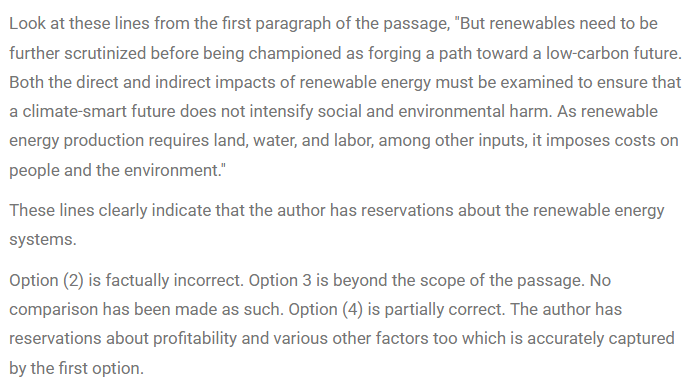CAT RC Questions | CAT RC Based on Natural Science questions
FundaMakers is the Best CAT Online Coaching In India. Now prepare for CAT anytime with FundaMakers. We provide well-ordered syllabus coverage for both offline and online CAT preparation batches. FundaMakers brings to you the power-packed, well-structured CAT previous year question bank with more than 4000+ CAT Past Year questions. In the VARC section, one of the most frequently asked questions is from the topic- Reading Comprehension. Reading Comprehension turns out to be an important part of the VARC section from which over 60-70% of the questions are based on RC in the CAT Exam.
FundaMakers as a team has taken a painstaking step to bring you all the video solutions of the Reading Comprehension asked in the Previous Year CAT exam. CAT question bank offered by FundaMakers is a power-packed topic-wise compilation of the entire CAT previous year questions. Questions from the Reading Comprehension topic are some of the most scoring questions in the VARC section. To maximize your CAT score make use of FundaMakers CAT Question Bank. “Questions from CAT previous years” examination papers have been incorporated. Let’s get started with CAT Past Year Reading Comprehension Questions.
Comprehension
Directions for question: Read the passage carefully and answer the given questions accordingly
In a low-carbon world, renewable energy technologies are hot business. For investors looking to redirect funds, wind turbines and solar panels, among other technologies, seem a straightforward choice. But renewables need to be further scrutinized before being championed as forging a path toward a low-carbon future. Both the direct and indirect impacts of renewable energy must be examined to ensure that a climate-smart future does not intensify social and environmental harm. As renewable energy production requires land, water, and labor, among other inputs, it imposes costs on people and the environment. Hydropower projects, for instance, have led to community dispossession and exclusion . . . Renewable energy supply chains are also intertwined with mining, and their technologies contribute to growing levels of electronic waste . . . Furthermore, although renewable energy can be produced and distributed through small-scale, local systems, such an approach might not generate the high returns on investment needed to attract capital.
Although an emerging sector, renewables are enmeshed in long-standing resource extraction through their dependence on minerals and metals . . . Scholars document the negative consequences of mining . . . even for mining operations that commit to socially responsible practices[:] “many of the world’s largest reservoirs of minerals like cobalt, copper, lithium, [and] rare earth minerals”—the ones needed for renewable technologies—“are found in fragile states and under communities of marginalized peoples in Africa, Asia, and Latin America.” Since the demand for metals and minerals will increase substantially in a renewable-powered future . . . this intensification could exacerbate the existing consequences of extractive activities.
Among the connections between climate change and waste, O’Neill . . . highlights that “devices developed to reduce our carbon footprint, such as lithium batteries for hybrid and electric cars or solar panels[,] become potentially dangerous electronic waste at the end of their productive life.” The disposal of toxic waste has long perpetuated social injustice through the flows of waste to the Global South and to marginalized communities in the Global North . . .
While renewable energy is a more recent addition to financial portfolios, investments in the sector must be considered in light of our understanding of capital accumulation. As agricultural finance reveals, the concentration of control of corporate activity facilitates profit generation. For some climate activists, the promise of renewables rests on their ability not only to reduce emissions but also to provide distributed, democratized access to energy . . . But Burke and Stephens . . . caution that “renewable energy systems offer a possibility but not a certainty for more democratic energy futures.” Small-scale, distributed forms of energy are only highly profitable to institutional investors if control is consolidated somewhere in the financial chain. Renewable energy can be produced at the household or neighborhood level. However, such small-scale, localized production is unlikely to generate high returns for investors. For financial growth to be sustained and expanded by the renewable sector, production and trade in renewable energy technologies will need to be highly concentrated, and large asset management firms will likely drive those developments.
CAT/2020.2
Question . 47
Which one of the following statements, if true, could be an accurate inference from the first paragraph of the passage?
Explanatory Answer
Method of solving this CAT RC Question from RC Based on Natural Science question
Correct Option: A

Hey!
Worried about IIM calls due to your marks in 10th,12th, and Graduation?
Don't worry! Know your chances of getting an IIM Call based on your profile with our:-
Profile Professor: https://fundamakers.com/profile-professor/

5 Must- NOT-Dos during CAT Preparation.
- Do not treat CAT as 'Everything'.
- Do not quit your job for CAT exam preparation.
- Learning till The Eleventh hour instead of doing proper revision.
- Not checking the syllabus thoroughly.
- Piling up multiple books.
Click To Read:- Common mistakes made by CAT aspirants during preparation.
FundaMakers- Best Online and Offline CAT Online Preparation Institute in India
For any CAT Preparation related query, reach out to us at 9598333344.